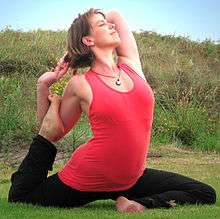Kapotasana


Kapotasana (Sanskrit: कपोतासन; IAST: Kapotāsana) or Pigeon Pose[1] is an asana.
Etymology
The name comes from the Sanskrit words kapota (कपोत) meaning "pigeon"[1] and asana (आसन) meaning "posture" or "seat".[2]
Description
There seem to be two very different poses that go by the name of Kapotasana, in addition to variations of both. In Vinyāsa and other practices, it involves one leg out front, with the shin perpendicular, parallel to the front of the mat. The other leg is stretched out straight behind. The body is held upright and the foot may be held in a hand, or in the crook of the elbow. The other variation from Ashtanga tradition is an advanced asana which resembles Chakrasana, or Wheel Pose, which is also called Urdva Dhanurasana or Upward Bow. The difference being that instead of hands and feet on the ground, the shins and forearms are on the ground, the front body stretched upwards in the air. The pose is reached by going through a process like going into Camel (Ustrasana), but requires more flexibility to bring the head back until it reaches the ground. This Kapotasana is an asana which helps to open up the chest and also strengthens the back and groin. It opens and increases the flexibility of the hips, at the same time strengthening the back, and stretching the thighs and the groin.
See also
References
- 1 2 "Kapotasana A - AshtangaYoga.info". Retrieved 2011-04-09.
- ↑ Sinha, S.C. (1 June 1996). Dictionary of Philosophy. Anmol Publications PVT. LTD. p. 18. ISBN 978-81-7041-293-9. Retrieved 9 April 2011.
Further reading
- Iyengar, B. K. S. (1 October 2005). Illustrated Light On Yoga. HarperCollins. ISBN 978-81-7223-606-9. Retrieved 9 April 2011.
- Saraswati, Swami Satyananda (1 August 2003). Asana Pranayama Mudra Bandha. Nesma Books India. ISBN 978-81-86336-14-4. Retrieved 9 April 2011.
- Saraswati, Swami Satyananda (January 2004). A Systematic Course in the Ancient Tantric Techniques of Yoga and Kriya. Nesma Books India. ISBN 978-81-85787-08-4. Retrieved 9 April 2011.